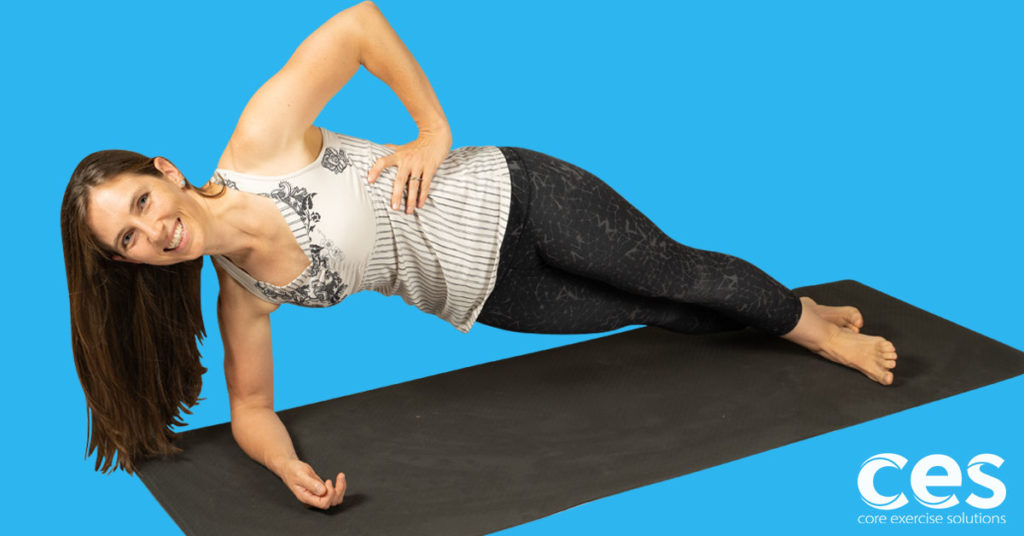Side planks are an AMAZING exercise, but they can easily be turned into a back exercise instead of an abdominal exercise.
They are a great exercise because they target the lateral abdominal complex. This includes the transverse abdominals, internal obliques and external obliques. Another key muscle that side planks work is the glute medius. Most people could use a little more glute med in their lives. 🙂 I like to bias the side plank and get a little adductor as well, because this leg muscle also tends to be on the weak side, especially in postpartum women.
Side planks can also be a great time to work on breathing and getting eccentric loading of those lateral abdominals. Let’s dive in and take a closer look at a few tips to help you get the most out of your side plank time.
Check your side planks with these 5 tips.
1. Check your head positioning.
Your head should be back in line with your body. Think about straight posture vs forward head posture. Can you picture it? Let’s not have forward head hunched posture when you side plank.
Keeping your head in line with your body helps align the scapula (shoulder blade) which helps the serratus kick in more to hold you up. When your serratus works more your upper traps work less. I’d call less neck tightness a win!
2. Check for a twist in your trunk.
Make sure your ribcage and pelvis face the same direction. If the ribcage faces down and the pelvis up, this creates a twist that can make your back muscles work overtime. That QL (quadratus lumborum) especially loves to overwork here and this is a common spot people complain about back tightness in. So, let’s make sure it’s nice and relaxed and not overworking to hold your side plank.
3. Check your breathing.
Try to direct your inhales deeply into your back. This is the perfect time to get those lateral abs to lengthen under load. Your body weight is the load and your nice big inhale is the lengthening. Let’s see lots of movement in those lateral abs for your nice deep inhale. Then, focus more on making the exhale come from the front. That will deepen the abdominal intensity vs recruiting your back muscles more.
Focusing on breathing is also a great opportunity to work on pressure management in both the linea alba (bulging in your abdomen) and pelvic floor. Is your pressure going down or out or is it equalizing throughout your entire trunk?
4. Check for a bend in your hips.
Look down and make sure your hips are not flexed and you are extended and in a straight line. We want abs and glutes holding you up, not hip flexors. When you let a small bend happen in the hips (like you’re going to sit), then the hip flexors think they can take over to hold you up. Keeping your hips nice and straight allows for the glute medius and abdominals to take more of the load and give your TFL a break!
5. Check for scrunching or sinking.
Focus on lengthening your abdominal and serratus to get better engagement and to manage pressure better. Try reaching your arm like I did with Jennifer in the video. Can you feel the difference? Feels good, doesn’t it? 🙂
What are the recommended reps and sets?
Well, I like to start on a surface height that’s comfortable so you can focus and not feel like everything is having to work for dear life to hold you up. This may mean a chair or even a high bed or counter.
Once you find the right starting height where you feel your abs working but it’s not intense, then I like to count reps by breaths. This helps you focus on the breathing aspect so you don’t just overbrace and slip into a shallow breathing pattern.
I’ve found that more than around 5-6 big breaths and people start to get dizzy. So, see how you feel but that might be where you want to cap it. If it’s easy, go to a lower surface. If the floor is easy, add a balloon. Then repeat for 2-4 sets.
Are you a fitness professional? The Pregnancy and Postpartum Corrective Exercise Specialist Course is the world’s leading women-focused corrective exercise certification for fitness and healthcare professionals.
Free Pelvic Floor Educational Series
Dr. Sarah Duvall, PT, DPT, CPT and the CES Team have helped thousands of women create the strength and stability needed to overcome common and not-so-common pelvic floor issues.
Join us today for this 4-part Pelvic Floor Video Series, absolutely free.
We don't spam or give your information to any third parties. View our Terms of Use and Privacy Policy.
Having trouble signing up? Click here


